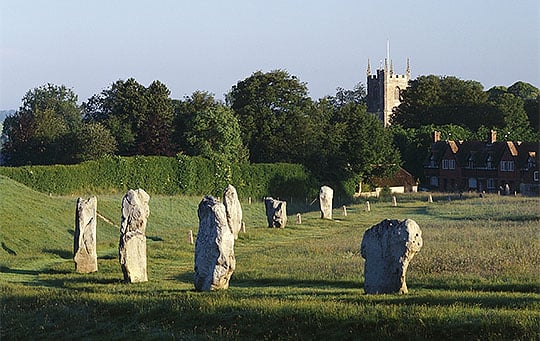Description of Avebury Henge and Stone Circles
Avebury consists of a huge circular bank and ditch with four causewayed entrances and an inner circle of upright stones enclosing a further two stone circles, each with a central feature. A double avenue of stones leads away from the southern entrance towards the Sanctuary stone circles on Overton Hill, about a mile to the south-east.

Banks and Causeways
The massive bank and ditch enclose an area of 28.5 acres (11.5 hectares).
The shape formed by the ditch is subcircular and is divided by causewayed entrances into four unequal arcs. The bank is now some 14–18 feet (4.2–5.4 metres) high but was once nearly 55 feet (17 metres) above what was originally a 30-foot (9-metre) deep ditch.
The bank of stark white chalk must have been a spectacular sight. It is as irregular as the ditch in shape and appears to have been built by different work gangs. Where the bank ended at an entrance, timber revetments appear to have been used to keep the bank in place.
The surfaces of the four causewayed entrances were reduced by scraping the top layer of chalk, so that the banks each side appeared even higher and more impressive.
There may also have been timber entrances of some kind, restricting access to the circles to only a few people at a time.
Together with the stones, the Great Henge at Avebury took many hundreds of thousands of hours to complete. It was one of the most labour-intensive Neolithic monuments in Britain along with Stonehenge and Silbury Hill.
Three Stone Circles
There are three great stone circles within the henge at Avebury: an outer circle and two smaller inner circles that were aligned more or less north and south.
The main outer circle probably had between 98 and 105 stones arranged around the perimeter edge of the surrounding ditch.
The stones were quite variable in shape and size, but the tallest ones stood at the northern and southern entrances to the henge – presumably placed to form impressive openings.
Southern Circle and Great Obelisk
The southern circle focused on a central point, the great Obelisk, which was the largest stone in the circle at 21 feet (6.4 metres) high.
This was removed sometime after 1725 and its former position is now represented by a concrete post. It was surrounded by 29 smaller stones, which formed the circle. These were set at regular intervals, about 36 feet (11 metres) apart, the same as the stones in the outer circles and also of roughly the same height.
Around the central point of the Obelisk, an arrangement of smaller rough sarsen stones formed a near rectangular enclosure that had already been staked out with wooden posts. When excavated this curious alignment was called the ‘Z’ feature. South of it was a single stone, perhaps lining up with the southern causewayed entrance.
Northern Circle
The northern circle probably consisted of 27 stones, also spaced at the interval used elsewhere at Avebury of about 36 feet (11 metres).
Most of the original stones are now missing, but two still stand and two more lie on the ground.
At the centre are the remains of the Cove, or the Devil’s Brandirons, as it was known.
This once consisted of three rectangular shaped sarsen stones, arranged around three sides of a square with the opening to the north. Although not visible today, it is likely that, like the Obelisk in the southern circle, the Cove was surrounded by rows or a ring of smaller sarsen stones.
Note
The text on this page is derived from the Heritage Unlocked series of guidebooks, published in 2002–6. We intend to update and enhance the content as soon as possible to provide more information on the property and its history.
